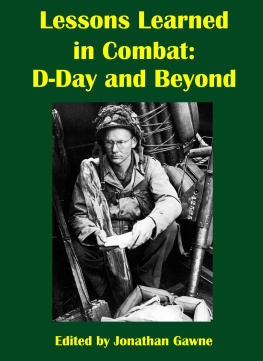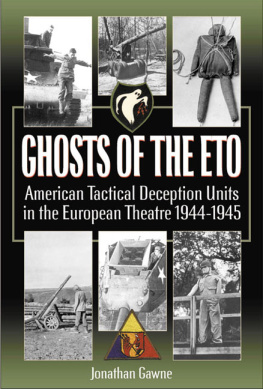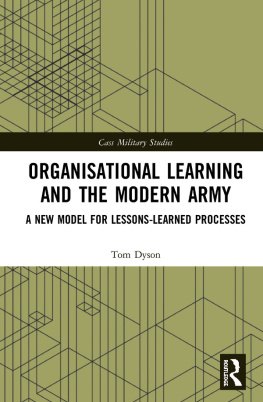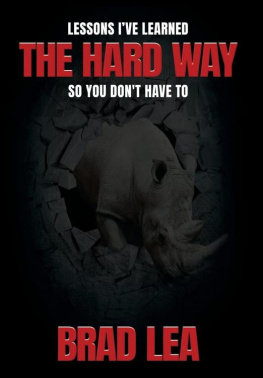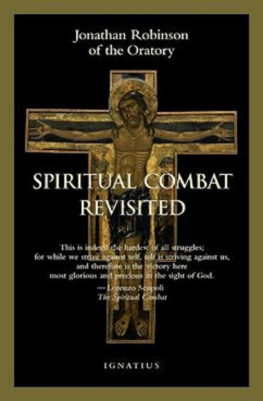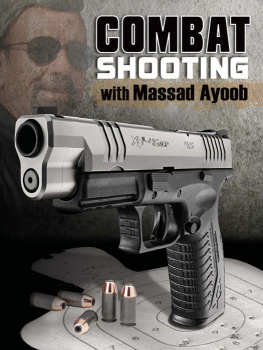Jonathan Gawne - Lessons Learned in Combat: D-Day and Beyond
Here you can read online Jonathan Gawne - Lessons Learned in Combat: D-Day and Beyond full text of the book (entire story) in english for free. Download pdf and epub, get meaning, cover and reviews about this ebook. year: 2013, publisher: Ballacourage Books, genre: Science fiction. Description of the work, (preface) as well as reviews are available. Best literature library LitArk.com created for fans of good reading and offers a wide selection of genres:
Romance novel
Science fiction
Adventure
Detective
Science
History
Home and family
Prose
Art
Politics
Computer
Non-fiction
Religion
Business
Children
Humor
Choose a favorite category and find really read worthwhile books. Enjoy immersion in the world of imagination, feel the emotions of the characters or learn something new for yourself, make an fascinating discovery.
- Book:Lessons Learned in Combat: D-Day and Beyond
- Author:
- Publisher:Ballacourage Books
- Genre:
- Year:2013
- Rating:4 / 5
- Favourites:Add to favourites
- Your mark:
- 80
- 1
- 2
- 3
- 4
- 5
Lessons Learned in Combat: D-Day and Beyond: summary, description and annotation
We offer to read an annotation, description, summary or preface (depends on what the author of the book "Lessons Learned in Combat: D-Day and Beyond" wrote himself). If you haven't found the necessary information about the book — write in the comments, we will try to find it.
Jonathan Gawne: author's other books
Who wrote Lessons Learned in Combat: D-Day and Beyond? Find out the surname, the name of the author of the book and a list of all author's works by series.
Lessons Learned in Combat: D-Day and Beyond — read online for free the complete book (whole text) full work
Below is the text of the book, divided by pages. System saving the place of the last page read, allows you to conveniently read the book "Lessons Learned in Combat: D-Day and Beyond" online for free, without having to search again every time where you left off. Put a bookmark, and you can go to the page where you finished reading at any time.
Font size:
Interval:
Bookmark:
Table of Contents
Lessons Learned in Combat:D-Day and Beyond
Edited by Jonathan Gawne
ASIN:
Published by Ballacourage Books, Framingham, MA.
copyright: Jonathan Gawne 2013

Cover photo. A soldier waits on board ship 1st Infantry Division. To his left is an explosive pole charge designed for anti-bunker use. He is holding his rifle, covered in a clear pliofilm (plastic) bag The straps of his assault vest, visible on his chest, are the ones that would swell up in water making the quick release function difficult to work. The unit serial number on the bazooka indicates this soldier is from Company I, 16th Infantry Regiment, 1st Infantry Division
Lessons Learned in Combat: D-Day and Beyond
Edited by Jonathan Gawne
Published by Ballacourage Books, Framingham, MA. copyright 2013
Introduction
After WW2, as part of a company grade officers training, they were required to write about a military subject; generally to analyze a battle. Thankfully for historians the Army not only allowed, but encouraged them to document an event they had taken part in and analyze and critique that event providing a list of Lessons Learned.
The human mind is a strange thing, especially when it comes to memory. Some veterans will remember their service in vivid detail; others have blocked almost all of it out. An interesting discovery in memory research has been that every time one pulls a memory from storage it can subtly shift. This has led to some people remembering things a certain way at one time, and a different way later on. The more one tells a story, the more it seems to shift without the subjects knowledge.
General John C. Raaen Jr. (retired), the D-Day company commander of the Headquarters Company, 5th Ranger Battalion, is a perfect example. In his memoir IMPACT he writes that after he had written a memoir of his D-Day actions in 1984, he found his original notes from 1945. He states when comparing the two What a shock! My memories 40 years later just did not reflect the one I had written contemporaneously with the action.
This is why the personal narratives from the Armys Officer Schools are so important; they were done only a few years after the event when things were fresh in their minds and very little had been written or televised about the subject. Ranks, therefore, given of the authors are of the postwar time when the paper was written.
Some of these papers are fascinating when it comes to details that were probably forgotten within a few years. Often the men were still in touch with soldiers they had served with to get additional viewpoints or information.
Buried for years in filing cabinets, today they are primary source documents of incredible value when studying the war. In bringing them to print I have strived to keep them in as original a format as possible, while making them readable. Some of the authors were, to be blunt, not very good writers. Spelling and grammatical errors have been corrected, paying close attention not to alter the meaning of the words. In some cases minor changes had to be made to make the material comprehensible. The original footnotes of sources used have been turned into endnotes with numbers. Editorial annotations to clarify or point out something unusual have been added as footnotes using letters. Some of the military designations, such as unit, rank, or other terms were standardized. Codenames have been capitalized, and enemy units are named in italics.
Some may find the background material at the start of each section to be boring and repetitious: in many cases it is. However it was included to be true to the original document, and at times provides an interesting viewpoint on what the officer found important to mention, or knew from personal experience.
I have also added the original U.S. Army Historian's Group Critique Notes for OMAHA Beach. These form the basis for S.L.A. Marshall's story "First Wave at Omaha Beach." Anyone interested in the veracity of Marshall's work should sit down and compare these notes to the story.
Photos and maps: All of the photos have been added by the editor (with the exception of the one showing the burning ammo dumps behind OMAHA Beach). The maps are scans of the originals drawn by the author's own hands. Two of the maps (noted in the text) have sadly been lost to time. These maps have been embedded at a higher resolution to allow them to be expanded (if possible on your reader).
Place names: It is well known that French town names are often mangled by Americans. In cases where it was obvious what a misspelled name was I have corrected it. If not sure, I have left it as is.
Footnotes and endnotes: The original citations to where the information comes from have been converted from footnotes to endnotes and use numbers (1,2,3). To clarify or expand upon the text I have added in footnotes and use letters for them. (A,B,C)
You may notice an emphasis on supply and other non-combat functions. There is an old saying, amateurs discuss tactics, professionals discuss logistics. It would be nice if every officer in the first wave had been able to write his own personal narrative, but the number is limited. On the other hand, much of this logistical information is not easily available, often overlooked, and just as important.
For those who have an interest in the actual mechanics of the invasion, the editors book 'Spearheading D-Day' (Histoire et Collections, 1998) is still one of the best ways to learn about the minutiae of how the invasion was put together, and how the specialized elements were trained, organized and equipped. It also contains some interesting material on why the troops at Utah Beach landed off target. For more information on the combat activities on and off the beach, the books of Joseph Balkoski are highly recommended ('Beyond the Beachhead', 'Omaha Beach', 'and Utah Beach').
Table of Contents
1. Personal Experience of a Corps Battalion Operations Officer, by Major Edwin W. Elder, Jr. The operations of the 3rd Battalion, 16th Infantry (1st Infantry Division) in the assault landing and establishment of the beachhead on OMAHA Beach. 2. Personal Experience of a Heavy Weapons Company Commander by Captain Charles H. Kidd. The Operations of Company M, 116th Infantry (29th Infantry Division) in the Landing on Omaha Beach, 6-13 June 1944. 3. Personal Experience of an M.P. Platoon Executive Officer by Captain Charles M. Conover. The Operations of the Military Police Platoon, (1st Infantry Division) In the Establishment of the OMAHA Beachhead, June 6, 1944. 4. Personal Experience of an Infantry Company Commander Defending In Hedgerow Country, by Captain Linwood W. Billings. The Operations of Company L, 26th Infantry (1st Infantry Division) at St. Anne, France, 8-9 June 1944. 5. Personal Experience of a Platoon Leader, by Captain Ritter H. LaRue The Operations of Company I, 3rd Battalion, 26th Infantry (1st Infantry Division) In the Attack of Agy, France Southeast Of OMAHA Beach, Normandy 9-11 JUNE 1944. 6. Personal Experience of an OPERATIONAL Supply Officer, by Lt. Colonel Francis Deisher. Supply Operations in the Bristol Channel Area during Operation OVERLORD. 7. Personal Experience of an Officer in Loading an Armored Division, by Lt. Colonel Frank M. Muller . Combat Leading of the 2nd Armored Division for Amphibious Operations Invasions of Morocco, Sicily and Normandy. 8. Personal experience of a Depot S-4, by Reynolds A. Atlas. The Operations of Ammunition Depots in Normandy from D-Day to the Battle of St. Lo. 9. Personal experience of an Armored Battalion S-4, by Captain Joseph W. Jarvis . Tank Battalion Supply Procedure during Combat. 10. Personal Experience of a Battalion Operations Officer, by Lt Colonel George L. Mabry. Operations of 2nd Battalion, 8th Infantry, 4th Infantry Division in the landing at Utah Beach. 11. Personal experience of a Corps Liaison Officer, by Captain Charles I. Balcer. Operations of the VII Corps, FIRST U. S. Army in the Landing on UTAH Beach, Normandy, France, 6 7 June 1944. 12. Personal Experience of a Tank Destroyer Battalion Operations Officer, by Major Daniel M. Carter. The Operations of the 899th Tank Destroyer Battalion (Attached To the 4th Infantry Division) For the Period of 2 18 June 1944. 13. Personal Experience of a Cavalry Reconnaissance Officer, by Major Norman O. Brooks. Mechanized Reconnaissance from D-Day to St. Lo. 14. Personal Experience of an Infantry Company Commander Attacking In a Town, by Captain Preston Gordon . The Operations of Company E, 39th Infantry at Cherbourg, France. 15. 29th Division D-Day Group Critique Notes 16. Glossary of termsNext page
Font size:
Interval:
Bookmark:
Similar books «Lessons Learned in Combat: D-Day and Beyond»
Look at similar books to Lessons Learned in Combat: D-Day and Beyond. We have selected literature similar in name and meaning in the hope of providing readers with more options to find new, interesting, not yet read works.
Discussion, reviews of the book Lessons Learned in Combat: D-Day and Beyond and just readers' own opinions. Leave your comments, write what you think about the work, its meaning or the main characters. Specify what exactly you liked and what you didn't like, and why you think so.

